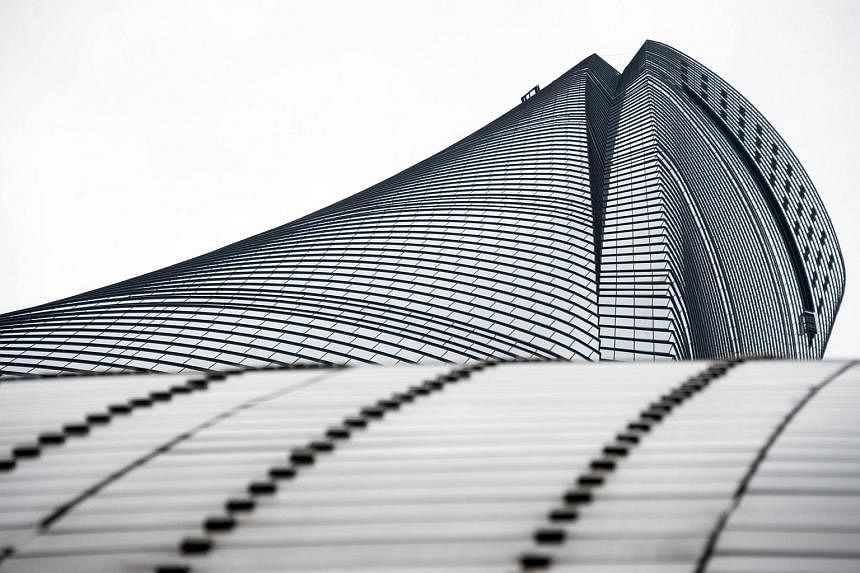SHANGHAI (AFP) - The world's second-tallest building, the Shanghai Tower, will soon open in the Chinese financial capital with a twist - a 120-degree twist, to be exact.
A softened triangular "outer skin" is literally twisted around a circular core, sending the glass and steel tower spiralling 632m into the grey sky above the city.
State-backed developer Shanghai Tower Construction and Development Co. views the modern design as a symbol of China's future, a super-tall building in the city's gleaming Pudong financial district, which did not even exist 25 years ago.
People involved with the project said the building will open this summer, with office tenants moving in first, but the developer declined to comment. "This twist is an iconic symbol of looking forward for the Chinese people," said Grant Uhlir, practice area leader and principal for Gensler, the US architecture firm whose design was chosen for the building which broke ground in 2008. "It's been referred to as a strand of DNA. It's also been referred to a place where the ground connects with the sky."
Although still dwarfed by the reigning champion Burj Khalifa in Dubai, which stands at 828m, and with new challengers under construction, the US$2.4 billion (S$3.2 billion) Shanghai Tower can still lay claim to a host of superlatives.
Besides being the tallest double-facade building, the world's fastest elevators travelling 18m per second will whisk people up and down while the globe's second-highest hotel will be located on the 84th to 110th floors.
An estimated 16,000 to 18,000 people will pass through the Shanghai Tower every day. The building will sway up to 1m in high winds, with a 1,000-tonne "damper" weight near the top reducing the effect.
"When you do these iconic, super-tall buildings, it can't be a copy of something else. It has to be unique," said American chief architect Marshall Strabala, who participated in the project while at Gensler.
Now the head of his own firm, he spent part of his three-decade career working on some of the world's tallest buildings including the Burj Khalifa.
He said the double skin plays other roles besides pure design, providing insulation to keep the building cool in summer and warm in winter and reducing wind stress.
"This building is a giant Thermos bottle, that's all it is," he said.
But the vacuum flask metaphor masks the mind-numbing complexity involved in balancing the design, safety requirements, building codes and client demands that shaped the tower.
Despite the futuristic look, concepts owing to Chinese culture are present.
A golden canopy at the base of the building was originally meant to be green, the colour of weathered copper, but the developer rejected the idea because in Chinese, the expression "wearing a green hat" means being a cuckold.
"It's not a good thing. Gold is a colour of prosperity," Mr Strabala said.
A white stone structure dubbed the "River Wall" on the lower floors conceptually cuts the building into west and east, like Shanghai itself is divided into Puxi and Pudong on either side of the Huangpu River.
"Pudong side is business, Puxi side is fun. The retail, restaurants (in the building) are on the fun Puxi side," Mr Strabala said.
The developer is expected to shun using floor numbers with the number four, which sounds like the Chinese word for death.
Gensler says the building has 121 "occupied" floors, while the total number has been given as 127 or 128 storeys depending on how they are counted.
Office space will take up much of the 573,000 sq m building, while the retail space is small compared to a shopping mall - just four floors.
The building's arrival on the Shanghai office market could potentially pull down rents and drive up the vacancy rate, analysts said.
"It remains to be seen whether the pool of tenants currently in Pudong is large enough to fill the building or whether Shanghai Tower will need to start offering discounts to attract others," said Mr Michael Stacy, executive director of Cushman & Wakefield's tenant advisory group in China.
Property agents are quoting rental rates in a range of 9 yuan to 16 yuan (S$1.90 to S$3.50) per square metre a day depending on location, but they say the developer is offering rent-free periods.
Mr Strabala believes the prestige of the address will draw tenants though he jokes about the "curse" of tall buildings, which seems to follow economic strife.
Workers broke ground on Shanghai Tower in November 2008, just weeks after the collapse of Lehman Brothers, which helped spark the global financial crisis, and it will open at a time when China's economy is slowing.
Mr Strabala, however, is not worried, stressing that recognition of the building as the world's second tallest will attract tenants.
"This building will fill up because people will want to be here," he said.

